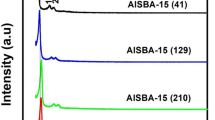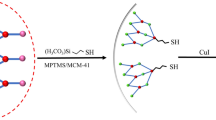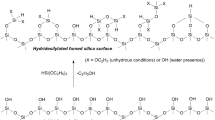Abstract
A new approach for the synthesis of zero-valent copper nanoparticles (CuNPs) supported on ordered mesoporous silica SBA-15 and SBA-16 by using vegetal antioxidants, coffee Robusta and green tea was developed in the present work. Diverse characterization techniques such as X-ray diffraction, nitrogen adsorption–desorption, transmission electron microscopy, thermogravimetric analysis, Fourier transform infrared spectroscopy and thermal programmed desorption of CO2 and water allowed stating that the appreciable specific surface area and porosity favor CuNP formation. Copper-loaded SBA-15 and SBA-16 exhibited higher surface basicity and hydrophilic character according to the type of the source of reducing agents and silica framework, respectively. OH-compounds interactions with both CuNP and SBA surface and more particularly with available Si–O-Si groups were found to promote metal dispersion reducing the particle size. The results obtained herein open promising prospects for designing low cost and “green” silica-based materials with judiciously tailored basicity and hydrophilic character for catalysis, adsorption and other surface processes.














Similar content being viewed by others
Data availability
Not applicable.
Code availability
Not applicable.
References
Ahmad N (2012) Rapid green synthesis of silver and gold nanoparticles using peels of Punica granatum. Adv Mater Lett 3:376–380
Albayati TM, Kalash KR (2020) Polycyclic aromatic hydrocarbons adsorption from wastewater using different types of prepared mesoporous materials MCM-41in batch and fixed bed column. Process Saf Environ Prot 133:124–136
Aree T (2019) Understanding structures and thermodynamics of beta-cyclodextrin encapsulation of chlorogenic, caffeic and quinic acids: Implications for enriching antioxidant capacity and masking bitterness in coffee. Food Chem 293:550–560
Azzouz A, Nousir S, Bouazizi N, Roy R (2015) Metal-inorganic-organic matrices as efficient sorbents for hydrogen storage. Chemsuschem 8:800–803
Bargougui R, Bouazizi N, Ammar S, Azzouz A (2016) Molybdenum-Loaded Anatase TiO2 Nanoparticles with enhanced optoelectronics properties. J Electron Mater 46:85–91
Bhagiyalakshmi M, Hemalatha P, Ganesh M, Peng MM, Jang HT (2011) Synthesis of copper exchanged heteropolyacids supported on MCM-48 and its application for CO2 adsorption. J Ind Eng Chem 17:628–632
Bindhu MR, Sathe V, Umadevi M (2013) Synthesis, characterization and SERS activity of biosynthesized silver nanoparticles. Spectrochim Acta, Part A 115:409–415
Bodo R, Ahmanache K, Hausler R, Azzouz A (2004) Optimized extraction of total proteic mass from water hyacinth dry leaves. J Environ Eng Sci 3:529–536
Bodo R, Hausler R, Azzouz A (2006) Approche multicritère pour la sélection de plantes aquatiques en vue d’une exploitation rationnelle. Rev Sci Eau 19:181–197
Bouazizi N, Ouargli R, Nousir S, Slama RB, Azzouz A (2015) Properties of SBA-15 modified by iron nanoparticles as potential hydrogen adsorbents and sensors. J Phys Chem Solids 77:172–177
Bouazizi N, Louhichi S, Ouargli R, Bargougui R, Vieillard J, Derf FL, Azzouz A (2017) Cu0 -loaded SBA-15@ZnO with improved electrical properties and affinity towards hydrogen. Appl Surf Sci 404:146–153
Bouazizi N, Ouargli R, Nousir S, Azzouz A (2019) Copper and palladium loaded polyol dendrimer-montmorillonite composites as potential adsorbents for CO2 and H2, J. Mater. Sci.: Mater. Electron. 30:8182–8190
Cao X, Li L, Shitao Y, Liu S, Hailong Y, Qiong W, Ragauskas AJ (2019) Catalytic conversion of waste cooking oils for the production of liquid hydrocarbon biofuels using in-situ coating metal oxide on SBA-15 as heterogeneous catalyst. J Anal Appl Pyrolysis 138:137–144
Chacko SM, Thambi PT, Kuttan R, Nishigaki I (2010) Beneficial effects of green tea: a literature review. Chin Med 5:13
Couillaud S, Kirikova M, Zaïdi W, Bonnet J-P, Marre S, Aymonier C, Zhang J, Cuevas F, Latroche M, Aymard L, Bobet J-L (2013) Supercritical fluid chemical deposition of Pd nanoparticles on magnesium-scandium alloy for hydrogen storage. J Alloys Compd 574:6–12
Ding Y, Xian Q, Jiang Z, Chen L, Xiong T, He X, Yang W, Dan H, Duan T (2020) Immobilization of uranium in cristobalite ceramic through adsorption on mesoporous SBA-15 and further sintering process. J Eur Ceram Soc 40:2113–2119
Duval Y, Mielczarski JA, Pokrovsky OS, Mielczarski E, Ehrhardt JJ (2002) Evidence of the existence of three types of species at the quartz-aqueous solution interface at pH 0–10: XPS surface group quantification and surface complexation modeling. J Phys Chem B 106:2937–2945
Ertürk AS (2019) Biosynthesis of silver nanoparticles using Epilobium parviflorum green tea extract: analytical applications to colorimetric detection of Hg2+ ions and reduction of hazardous organic dyes. J Cluster Sci 30:1363–1373
Farah A, de Paulis T, Trugo LC, Martin PR (2005) Effect of roasting on the formation of chlorogenic acid lactones in coffee. J Agric Food Chem 53:1505–1513
Gonzalez G, Sagarzazu A, Cordova A, Gomes ME, Salas J, Contreras L, Noris-Suarez K, Lascano L (2018) Comparative study of two silica mesoporous materials (SBA-16 and SBA-15) modified with a hydroxyapatite layer for clindamycin controlled delivery. Microporous Mesoporous Mater 256:251–265
Guzman A, Arroyo J, Verde L, Rengifo J (2015) Synthesis and characterization of copper nanoparticles/polyvinyl chloride (Cu NPs / PVC) nanocomposites. Procedia Mater Sci 9:298–304
Hakiki A, Boukoussa B, Zahmani HH, Hamacha R, el HoudaHadj N, Abdelkader F, Bekkar F, Bettahar AP, Nunes-Beltrao S, Hacini A, Bengueddach A. Azzouz (2018) Synthesis and characterization of mesoporous silica SBA-15 functionalized by mono-, di- and tri-amine and its catalytic behavior towards Michael addition. Mater. Chem. Phys. 212:415–425
Herrera J, Kwak J, Hu J, Wang Y, Peden C, Macht J, Iglesia E (2006) Synthesis, characterization and catalytic function of novel highly dispersed tungsten oxide catalysts on mesoporous silica. J Catal 239:200–211
Hussain AA, Nazir S, Irshad R, Tahir K, Raza M, Khan ZUH, Khan AU (2021) Synthesis of functionalized mesoporous Ni-SBA-16 decorated with MgO nanoparticles for Cr (VI) adsorption and an effective catalyst for hydrodechlorination of chlorobenzene. Mater Res Bull 133:111059
Hwang SJ, Jun SH, Park Y, Cha SH, Yoon M, Cho S, Lee HJ, Park Y (2015) Green synthesis of gold nanoparticles using chlorogenic acid and their enhanced performance for inflammation. Nanomedicine 11:1677–1688
Irshad R, Tahir K, Li B, Ahmad A, Siddiqui AR, Nazir S (2017) Antibacterial activity of biochemically capped iron oxide nanoparticles: a view towards green chemistry. J Photochem Photobiol b: Biol 170:241–246
Kilmartin P (2003) Characterisation of polyphenols in green, oolong and black teas, and in coffee, using cyclic voltammetry. Food Chem 82:501–512
Klatsky AL, Armstrong MA, Friedman GD (1993) Coffee, tea and mortality. Ann Epidemiol 3:375–381
Kubota S, Morioka T, Takesue M, Hayashi H, Watanabe M, Smith RL (2014) Continuous supercritical hydrothermal synthesis of dispersible zero-valent copper nanoparticles for ink applications in printed electronics. J Supercrit Fluids 86:33–40
Liu R, Cai W, Ni X, Shi L, Wang R, Lin S (2020) Ultrastable and strongly acidic Al-SBA-15 with superior activity in LDPE catalytic cracking reaction. J Solid State Chem 286:121319
Marcos FCF, Assaf JM, Assaf EM (2018) CuFe and CuCo supported on pillared clay as catalysts for CO2 hydrogenation into value-added products in one-step. Mol Catal 458:297–306
Meynen V, Cool P, Vansant EF (2009) Verified syntheses of mesoporous materials. Microporous Mesoporous Mater 125:170–223
Mukherjee S, Chowdhury D, Kotcherlakota R, Patra S, Vinothkumar B, Bhadra MP, Sreedhar B, Patra CR (2014) Potential theranostics application of bio-synthesized silver nanoparticles (4-in-1 system). Theranostics 4:316–335
Neek M, Kim TI, Wang S-W (2019) Protein-based nanoparticles in cancer vaccine development. Nanomed Nanotechnol Biol Med 15:164–174
Loo YY, Chieng BW, Nishibuchi M, Radu S (2012) Synthesis of silver nanoparticles by using tea leaf extract from Camellia sinensis. Int J Nanomed 4263–4267
Ouargli R, Hamacha R, Benharrats N, Boos A, Bengueddach A (2015) β-diketone functionalized SBA-15 and SBA-16 for rapid liquid-solid extraction of copper. J Porous Mater 22:511–520
Ouargli R, Bouazizi N, Khelil M, Nousir S, Benslama R, Ammar S, Azzouz A (2017) SBA-15-supported iron nanoparticles with improved optical properties, conductance and capacitance. Chem Phys Lett 673:30–37
Ouargli R, Larouk S, Terrab I, Hamacha R, Benharrats N, Bengheddach A, Azzouz A (2016) Intrinsic activity of SBA-like silica in the catalytic ozonation of organic pollutants. Ozone: Sci Eng 38:48–61
Ouargli-Saker R, Bouazizi N, Boukoussa B, Barrimo D, Paola-Nunes-Beltrao A, Azzouz A (2017) Metal-loaded SBA-16-like silica - correlation between basicity and affinity towards hydrogen. Appl Surf Sci 411:476–486
Ouargli-Saker R, Bouazizi N, Lassouad S, Ammar S, Vieillard J, Le Derf F, Azzouz A (2020) Copper-loaded SBA-15 silica with improved electron mobility-conductance and capacitance properties. J Inorg Organomet Polym Mater 30:5108–5117
Pokrovsky OS, Golubev SV, Mielczarski JA (2006) Kinetic evidences of the existence of positively charged species at the quartz-aqueous solution interface. J Colloid Interface Sci 296:189–194
Qiang T, Song Y, Zhao J, Li J (2019) Controlled incorporation homogeneous Ti-doped SBA-15 for improving methylene blue adsorption capacity. J Alloy Compd 770:792–802
Rahman SU, Huang Y, Zhu L, Feng S, Khan IM, Wu J, Li Y, Wang X (2018) Therapeutic role of green tea polyphenols in improving fertility: a review. Nutrients 10:834–837
Reardon EJ (2014) Capture and storage of hydrogen gas by zero-valent iron. J Contam Hydrol 157:117–124
Reto M, Figueira ME, Filipe HM, Almeida CM (2007) Chemical composition of green tea (Camellia sinensis) infusions commercialized in Portugal. Plant Foods Hum Nutr 62:139
Scalbert A, Williamson G (2000) Dietary intake and bioavailability of polyphenols. J Nutr 130:2073S-2085S
Sharma S, Cheng S-F, Bhattacharya B, Chakkaravarthi S (2019) Efficacy of free and encapsulated natural antioxidants in oxidative stability of edible oil: Special emphasis on nanoemulsion-based encapsulation. Trends Food Sci Technol 91:305–318
Sing KSW (1982) Reporting physisorption data for gas/solid systems with special reference to the determination of surface area and porosity (Provisional). Pure Appl Chem 54:2201–2218
Song KC, Lee SM, Park TS, Lee BS (2009) Preparation of colloidal silver nanoparticles by chemical reduction method. Korean J Chem Eng 26:153–155
Subhan A, Irshad R, Nazir S, Tahir K, Ahmad A, Khan AU, Khan ZUH (2020) A new study of biomediated Pd/TiO2: a competitive system for Escherichia coli inhibition and radical stabilization. Mater. Res. Express 6:125430
Sulpizi M, Gaigeot M-P, Sprik M (2012) The silica-water interface: how the silanols determine the surface acidity and modulate the water properties. J Chem Theory Comput 8:1037–1047
Sun H, Tang Q, Du Y, Liu X, Chen Y, Yang Y (2009) Mesostructured SBA-16 with excellent hydrothermal, thermal and mechanical stabilities: modified synthesis and its catalytic application. J Colloid Interface Sci 333:317–323
Ullah S, Ahmad A, Wang A, Raza M, Jan AU, Tahir K, Rahman AU, Qipeng Y (2017) Bio-fabrication of catalytic platinum nanoparticles and their in vitro efficacy against lungs cancer cells line (A549). J Photochem Photobiol b: Biol 173:368–375
Vares G, Jallet V, Matsumoto Y, Rentier C, Takayama K, Sasaki T, Hayashi Y, Kumada H, Sugawara H (2020) Functionalized mesoporous silica nanoparticles for innovative boron-neutron capture therapy of resistant cancers. Nanomedicine: Nanotechnology, Biology and Medicine 27:102195
Venkatesan J, Kim S-K, Shim M (2016) Antimicrobial, antioxidant and anticancer activities of biosynthesized silver nanoparticles using marine algae Ecklonia cava. Nanomaterials 6:235–235
Vidhu VK, Philip D (2014) Catalytic degradation of organic dyes using biosynthesized silver nanoparticles. Micron 56:54–62
Wang M, Zhang W, Zheng X, Zhu P (2017) Antibacterial and catalytic activities of biosynthesized silver nanoparticles prepared by using an aqueous extract of green coffee bean as a reducing agent. RSC Adv 7:12144–12149
Wu ZG, Munoz M, Montero O (2010) The synthesis of nickel nanoparticles by hydrazine reduction. Adv Powder Technol 21:165–168
Xu R, Pang W, Yu J, Huo Q, Chen J (2007) Chemistry of zeolites and related porous materials. John Wiley & Sons, Ltd
Xu W, Fan Y, Liu X, Luo D, Liu H, Yang N (2018) Catalytic and antibacterial properties of silver nanoparticles green biosynthesized using soluble green tea powder. Mater Res Express 5:45029–45029
Yamagata K (2018) Do coffee polyphenols have a preventive action on metabolic syndrome associated endothelial dysfunctions? An assessment of the current evidence. Antioxidants (basel) 7:26
Yan Z, Zhong Y, Duan Y, Chen Q, Li F (2020) Antioxidant mechanism of tea polyphenols and its impact on health benefits. Anim Nutr 6:115–123
Zhang K, Suh JM, Choi J-W, Jang HW, Shokouhimehr M, Varma RS (2019) Recent advances in the nanocatalyst-assisted NaBH4 reduction of nitroaromatics in water. ACS Omega 4:483–495
Zhao D (1998) Triblock copolymer syntheses of mesoporous silica with periodic 50 to 300 angstrom pores. Science 279:548–552
Zhao D, Huo Q, Feng J, Chmelka BF, Stucky GD (1998) Nonionic triblock and star diblock copolymer and oligomeric surfactant syntheses of highly ordered, hydrothermally stable, mesoporous silica structures. J Am Chem Soc 120:6024–6036
Zhu S-B (1995) Interactions of water, ions and atoms with metal surfaces. Surf Sci 329:276–284
Zhuravlev LT (2000) The surface chemistry of amorphous silica. Zhuravlev model. Colloids Surf Physicochem Eng Aspects 173:1–38
Funding
Not applicable.
Author information
Authors and Affiliations
Contributions
Not applicable.
Corresponding author
Ethics declarations
Ethics approval
Not applicable.
Consent to participate
Not applicable.
Consent for publication
Not applicable.
Conflict of interest
The authors declare that they have no conflict of interest.
Additional information
Publisher's note
Springer Nature remains neutral with regard to jurisdictional claims in published maps and institutional affiliations.
Rights and permissions
About this article
Cite this article
Sekkal, K.N.E.H., Ouargli-Saker, R., Lachachi, A.K. et al. Effect of copper dispersion on SBA-15 and SBA-16 affinity towards carbon dioxide—an approach through thermal programmed desorption. J Nanopart Res 23, 154 (2021). https://doi.org/10.1007/s11051-021-05270-w
Received:
Accepted:
Published:
DOI: https://doi.org/10.1007/s11051-021-05270-w




